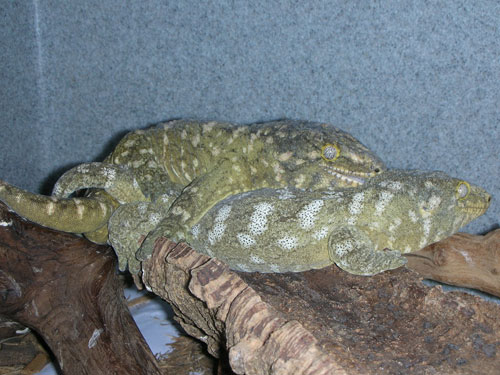Tips on breeding New Caledonian giant geckos.
The two most important things to keep in mind when breeding New Caledonian giant geckos (Rhacodactylus leachianus ) are maturity and compatibility. Nicknamed “leachies,” these geckos should be adult size (at least 120 grams for offshore-island geckos and more than 180 grams for mainland geckos) and at least 3 years old before attempting to pair them. Keep in mind that some animals may never be compatible, a problem that seems to occur more often with animals from Grande Terre. It is not uncommon for incompatible animals to seriously injure or even kill each other if left together, and this can occur quickly. Observing all pairings is essential for the animals’ safety.

Photo by Stephen Cemelli.
New Caledonian Giant Geckos.
Pair Up
Sexing adult animals is easy; mature males have two obvious hemipenal bulges. A jeweler’s loupe with a magnification of 10 can help sex juveniles by locating the femoral pores, which are found only on males. These pores are located on the underside of the rear legs and form a V shape in front of the vent.
Breeding pairs should consist of one male and one female. A few breeders, including myself, have tried to breed leachies in trios (one male and two females). In most cases the animals fought and had to be separated. Rotating a male between more than one female has been done with some success; however, this can be rough on the male because the original female from a successful pairing may reject her mate if he is reintroduced after mating with a second female.
Enclosures for a pair of offshore-island animals should be at least 3 feet long, 1½ feet wide and 2 feet tall. Caging for Grande Terre pairs should be 3 feet long, 1½ feet wide and 3 feet tall or larger.
First Impressions
A short cooling period is helpful to stimulate normal breeding activity. I find that maintaining temperatures in the lower 70s (degrees Fahrenheit) throughout the winter, around November to February, seems to do the trick.
Initial gecko introductions can be attempted during this cooling period. For safety reasons I find it best to put a small cage with a screen top inside the female’s enclosure, so the pair’s initial contact is through a screen, making it difficult to injure each other. The smaller cage can be approximately 20 inches long, 10 inches wide and 12 inches tall. A 10-gallon aquarium works well. I keep the male in the smaller cage for a few days. Temperatures can then be increased by 5 to 10 degrees during February through March.
Compatible pairs sometimes “bond” through the screen, and they may rest in close proximity to each other. Incompatible animals bark aggressively and sometimes try to attack each other through the screen. Even if animals appear compatible, always keep an open eye and ear for the first few days.
Gecko Introductions
Introduce animals during the day with food because two geckos with full stomachs under full lighting are more likely to hide together and get along. I feed both the day before and the day of introduction. Animals may feed simultaneously even after introduction. Animals that get along sometimes court one another through head-bobbing and clucking, or they may copulate immediately.
Even if you witness copulation, keep a close watch because these geckos may still fight a few days after copulation. Some pairs get along for years and then suddenly become incompatible. Some speculate this is caused by the female’s instinctual need for genetic diversity. Separate geckos at any sign of aggression.
Eggs and Incubation
A nest and humidity box should be made available at all times to a possibly gravid female. Eggs can usually be expected within 30 days of copulation. A clutch contains two eggs. One to six clutches are possible, but two to three clutches are the norm.
Fertile eggs hatch somewhere in the range of 45 to 150 days depending on incubation temperatures. Temperatures should range from the upper 60s to lower 80s. Eggs incubated at warmer temperatures typically produce a higher percentage of males and also hatch much more quickly.
Unfortunately, leachies are not always reliable producers. That is why they have remained pricey. Some pairs produce well for a few years and then stop with no explanation. I have also had pairs together for years and then, out of the blue, they fight and have to be separated. Inspect your geckos often, and separate them if necessary.
Hatchling and Juvenile Care
I keep my hatchlings and juveniles in individual shoebox enclosures 12 inches long, 7 inches wide and 4 inches tall. I add a coconut hide or a flat slab of cork bark large enough to allow water and food cups to be wedged into a corner. This keeps the gecko from flipping the cups. Paper towels line the bottom, and I change them one to two times a week. Fresh water is provided every other day, and I spill a small amount on the paper towel around the bowl to elevate the humidity.
When the gecko reaches a size where its waste is too much for paper towels, I switch to mulch. The side by the water is kept moist, and the other side is kept dry. This way the gecko can hydrate and then find a dry place to rest. The goal is air humidity — not a wet enclosure.


